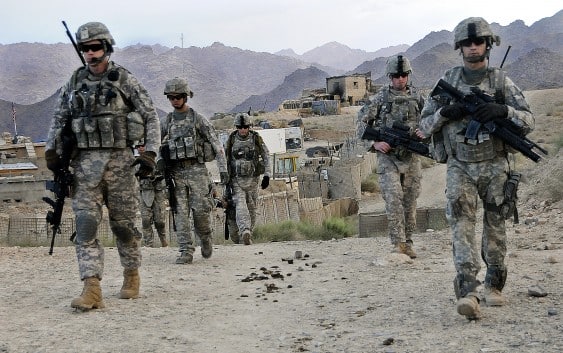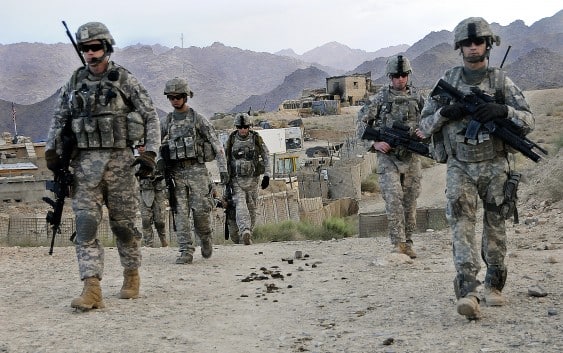US ground forces appear to be leaving Syria in spite of the efforts of those who are obsessed with the region and who seek to remain no matter the cost. Inexplicably, some who wish us to remain have responsibilities in the Trump Administration.
Our wars in the Middle East were lost the moment they began. These wars have proven costly in lives, wounded, populations displaced and destroyed, America’s alliances and standing in the world and trillions of dollars wasted. The greatest costs, however, have been incurred by allowing our obsession with the Middle East to permit Russia to expand its lead in military technology.
The War in Syria, like the rest of America’s 21st-century incursions into the Middle East, has been irretrievably lost. This reality, while dismissed in Washington, is recognized almost everywhere else.
Consider, for example, that in the past few days the Arab League has scheduled a vote — expected to easily pass — on reestablishing relations with Syria and reopening their Embassies in Damascus. The United Arab Emirates has already done so. Italy and Great Britain are renovating their Embassies in preparation for reopening. At the same time, the Iraqi Air Force is flying missions in support of the Syrian government. Recently, Syria has received, and is learning to operate, the very sophisticated Russian S-300 Anti-Aircraft System which works in concert with Syrian shorter range air defenses and Russian systems. Russian air defense and electronic warfare systems, along with Russian aircraft, operate from Russia’s two Syrian bases in support of Syrian military operations.
The Assad government controls almost everything in the two-thirds of the country west of the Euphrates River. Idlib Province, which borders Turkey in Syria’s northwest (the sole significant exception not under US control) is a mix of Al-Qaeda, Turkish, Uigher and other terrorists. The Turks prevailed on the Syrians and Russians to let them deal with Idlib Province. While under considerable stress, that agreement, for the moment, remains in place. The Al Tanf pocket, where the principal highway from Iraq crosses into Syria (near the area where Jordan, Syria and Iraq meet) remains under US control. East of the Euphrates (a far less populated area) the US-supported Kurds are present in force, along with isolated pockets of ISIS terrorists. The Kurds, aware that Assad has won the war and seeking to avoid a threatened Turkish invasion have, in the face of US objections, begun to turn over territory to the Syrian Army.
Consistent with our recent history, America’s foreign and military establishment seem determined to ignore our reduced influence in the region. Over Iraqi government objections, we have decided to move our forces from Syria just across the border to Iraq. This has, predictably, increased the ongoing discussion in Baghdad about barring US troops from Iraq entirely. Our diplomats have also made it clear that Turkey merits much less consideration than the Kurds. This too, will have lasting repercussions, as the Turks have been fighting a Kurdish separatist movement and related Kurdish terrorists since the late 1970s. Turkey, it should be remembered, is an important country — a NATO member in a critical strategic location with an important Air Force base (Incirlik) which, except when we fly missions in support of the Kurds, they permit us to use.
The US should exit Syria as soon as possible. Moving our forces across the border to Iraq, where they can quickly re-enter Syria, won’t satisfy the Syrian or Iraqi governments and merely increases the likelihood that the Iraqis will eventually, and perhaps quite soon, tell us to leave. The sooner we end our obsession with the Middle East — and leave both Syria and Iraq — the better.
After relegating the Middle East to its appropriate place in the list of threats America faces, America’s armed forces will need to focus on countering Russian advances in at least three critical areas:
Anti-Aircraft Systems
Russia’s most modern anti-aircraft system, the S-400 Triumf, is the most capable air defense system in the world – it has no real competitor. Consider some of the differences between the S-400 and the US Patriot/PAC-3. The S-400 can identify targets at 600 kilometers and engage targets at 400 kilometers. The Patriot can identify targets at 180 kilometers and engage targets at 96 kilometers. The S-400 can engage 72 and track 160 targets simultaneously. The Patriot can engage 36 and track 125 targets simultaneously. The S-400 can engage targets traveling at Mach 14, the Patriot can engage targets traveling at Mach 6.5. The S-400 can be deployed in 5 minutes, the Patriot in 30 minutes. Finally, the S-400 radar employs multiple frequency bands designed to identify stealth aircraft, the Patriot has a single passive radar. There is speculation that the S-400 system can track the F-35, our newest stealth aircraft. While the S-400 has not been tested in combat, the Patriot has and the results have been disappointing. S-400 purchasers include Turkey, China, India and Saudi Arabia. The Russians are also developing the S-500 system for defense against ballistic missiles, an area where the S-400 is less than fully capable. Our equivalent system is the Terminal High Altitude Area Defense (THAAD) System which, like the Patriot, has a disappointing record.
Missiles
Russia has recently tested the Avangard hypersonic glider, capable of traveling at Mach 27 with a range of 16,000 kilometers and which can repeatedly change course over its flight path. This system will be fielded this year. We have nothing capable of defending against it and are far behind in developing anything comparable. The Defense Advanced Research Projects Agency (DARPA), for example, recently announced that later this month they would be beginning an effort to “develop and demonstrate new design and material solutions for sharp, stable, cooled leading edges for hypersonic vehicles” – something they concede they haven’t been able to demonstrate practical concepts for in flight.
Electronic Warfare
Russia has a huge lead in electronic warfare. In April, 2014 the USS Donald Cook, one of our most modern destroyers, was cruising in the Black Sea when a Russian aircraft with an electronic pod buzzed the ship three times. On the third pass the Cook lost its electronics. While the electrical system was out, the Russian aircraft pretended to attack the ship. After a few minutes — fatal in an age of hypersonic missiles — the Cook’s power was restored. The Cook, which had been in the Black Sea beyond the time it was expected to be there, promptly left. The US Navy has indicated it will require that ships constructed in the future are resistant to electronic interference.
Russia, a country with an economy the size of Florida’s, has made some impressive technical advances. Historically a Continental as opposed to a Maritime Power, they have concentrated on defensive weapons. The Russian Navy is not a true blue-water navy in the sense the US Navy is, and their ability to project force overseas is therefore limited. That said, our forces are at a distinct disadvantage in the important areas noted. Until we end our obsession with the Middle East, which occupies an absurd amount of the Pentagon’s attention and money, our irresponsible leadership will continue to trifle with military disaster.
McConnell is Colonel, US Army Reserve, Retired and graduate of the US Army War College. Formerly a Member of the New Hampshire House of Representatives.


